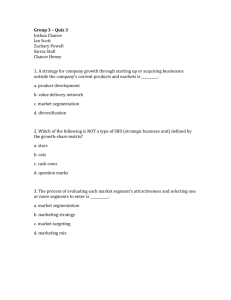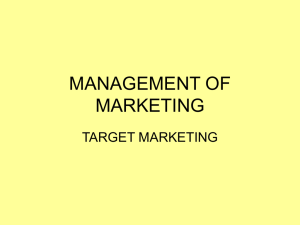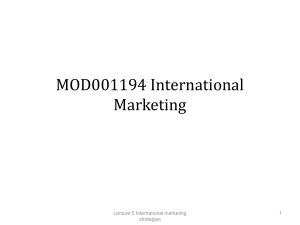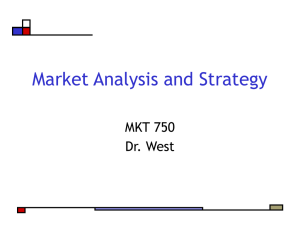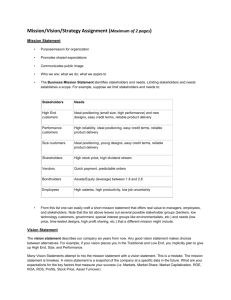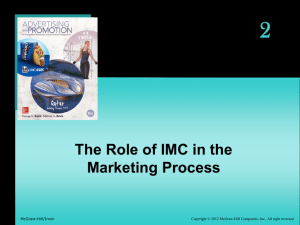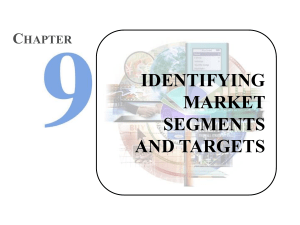Formulating Strategy to Fill Identified Needs Segmentation and
advertisement
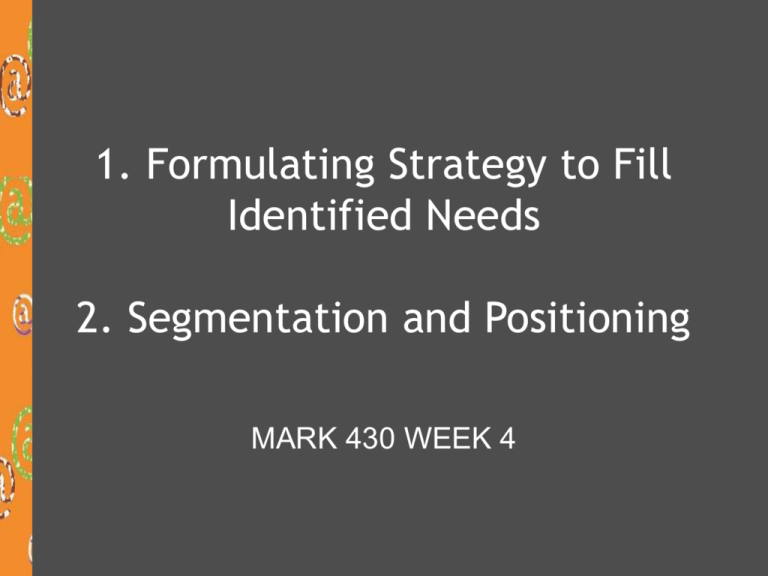
1. Formulating Strategy to Fill Identified Needs 2. Segmentation and Positioning MARK 430 WEEK 4 What we will cover this week... Now we have all that information about customer behaviour and customer needs.... what are we going to do with it? 1. Formulate a strategy to fill the needs that we have identified 2. Determine which customers to target, and how to position our product/service vis a vis the competition Main strategy tool: SWOT analysis Goal is to pursue opportunities that use your company’s strengths, while avoiding threats and overcoming weaknesses (Urban p 45) Strategy formulation Identify and rank strengths and weaknesses in your company / organization Technique: list key marketing success factors eg. high product quality customer loyalty patent protection rank your position relative to that of your competition against these factors much worse, worse, equal, better, much better Objective is to recognize, then build on your strengths and overcome your weaknesses Strategy formulation Identify and rate opportunities and threats in the external marketing environment Opportunities eg. technological change low entry costs market growth unmet customer need weak competition customer power..... Threats eg. technological change regulatory changes price war new competition social change customer power..... Customer power: both threat and opportunity More information, more options, simpler transactions More knowledge, more sophistication Threat to traditional marketing tactics - push based, one-way marketers must “make” customers buy Opportunity to attract the “new” customer trust-based marketing build mutually beneficial relationship Which strategic approach to follow? Which one to use: what kind of customers do you have? what kind of product/service are you providing? Push-based strategy commodities price sensitive deal seekers Pull (trust-based) strategy expensive / complex product information seeking customers customers that value long-term relationship The web is fundamentally a pull medium rather than a push medium Agree? Trust based marketing The web is really good an enabling trust building (a paradox?) HPs Online Advisor Acts as an online advisor, that helps people acquire products and services for their home. How does HP benefit? Benefits of trust-based marketing Fits the nature of the web medium Ebay - ratings of buyers and sellers without interference from EBay Amazon - customer ratings of products (does Amazon censor?) Collaborative filtering Reviews, customer ratings sites, blogs Less churn (cheaper to keep a customer than acquire a new one) Cheaper to serve. What we will cover this week... Now we have all that information about customer behaviour and customer needs.... what are we going to do with it? 1. Formulate a strategy to fill the needs that we have identified 2. Determine which customers to target, and how to position our product/service vis a vis the competition Which customers will you serve? Segmentation and Targeting Marketing segmentation the process of aggregating individuals or businesses with similar characteristics that relate to the use, consumption, or benefits of a product or service. Targeting the process of selecting the market segments that are most attractive to the firm Why segment? Customers prefer “custom” products The market of one? Cost How many segments should we deliver? What characteristics do we use to group people into market segments How do we know we are reaching those segments? Traditional marketing complaint I know I am wasting 50% of my advertising budget, but I don’t know which 50% Did the right segment see the ad? Internet technologies can answer that question much more effectively than traditional advertising media The Internet advantage The Internet is the marketer’s dream Ad server companies (eg. DoubleClick) compile and serve much narrower consumer segments than mass media Cost to deliver an ad is much smaller User registration info and cookies provide specific user data including what they did after they saw the ad immediately later Segmentation Bases and Examples of Related Variables Bases Geographics Demographics Psychographics Behavior Identifying / Profiling Variable Examples City County State Region Country Age Income Gender Education Ethnicity Activities Interests Opinions Personality Values Importances Benefits sought Usage level Brand loyalty User status VALS An example of a Marketing strategy tool (VALS stands for values and lifestyle, but now focuses on personality) segments the market on the basis of personality traits traits assumed to drive consumer behaviour uses a survey instrument The VALS personality types Primary and secondary types After Segmentation > Positioning Product positioning takes place within a target market segment Position is based on consumer perception What we need to know: What product dimensions/attributes do consumers use to evaluate? How important are these when decisions are made? How do we and our competitors sit relative to these dimensions One tool we can use is a Perceptual Map Perceptual Map: Automobiles Classy Distinctive Conservative Sporty Practical Affordable 2 uses for a perceptual map Identify areas without competitors Mercedes Honda Ford Nissan Porsche BMW Chrysler VW Hyundai Toyota Cadillac Dodge Jeep Saturn Kia Lexus Display consumer’s ideal points These points reflect ideal combinations of the two dimensions as seen by a consumer. Use them to identify potential market segments The Internet’s big promise is individualized targeting giving individual consumers exactly what they want at the right time and place.
